Top 6 known bugs in VMware vSphere 7
The version of VMware vSphere 7 has been out for some time now, but it hasn’t been without its share of bugs. While many of these issues have already been resolved, there are still a few that remain and often re-appear in later releases. In this blog post, we’ll take a closer look at the top 5 bugs in VMware vSphere 7 and how to resolve them.
Overview of VMware vSphere 7
VMware vSphere is a virtualization platform used to manage, monitor, and scale cloud infrastructure. With the release of vSphere 7, VMware has made significant updates to the platform that make it easier for engineers to deploy and maintain enterprise-level IT infrastructure. Let’s explore what this new version of vSphere offers.
What is VMware vSphere?
VMware vSphere is a suite of virtualization products designed to reduce the complexity of managing IT infrastructure. It provides features such as: server virtualization, storage management, network management, and application deployment. The latest version of vSphere is 7, which was released in April 2020.
What’s New in VMware vSphere 7?
vSphere 7 brings several improvements over its predecessor, including: improved scalability; faster provisioning times; enhanced security; robust storage capabilities; and more powerful performance monitoring tools. One of the biggest changes is the integration of Kubernetes into the platform—a feature that allows engineers to easily deploy applications across multiple nodes with minimal effort. This makes it much easier for organizations to deploy complex applications quickly and efficiently.
Another major change with vSphere 7 is the introduction of native encryption support. This means organizations can now encrypt their entire environment from end-to-end—including VMs, containers, data stores, and networks—without having to purchase additional software or hardware solutions. This provides an added layer of security for mission-critical applications and data sets that need extra protection against potential threats or vulnerabilities.
Bugs in vSphere 7
- Memory Leak Issue: This issue causes memory to be leaked from the host system when running certain operations in the virtual environment. To resolve this issue, upgrade to vSphere 7 Update 1 or later.
- ESXi Host Crashes During Installation: Some users have reported that their ESXi hosts can crash during installation with an error code “VMK_FATAL_ERROR 0x4”. To fix this bug, install the vCenter Server 6.7 U3 or later on your system before installing vSphere 7 Update 1a or later on your host system.
- VMXNET3 Networking Issues: This bug can cause VMXNET3 NICs to stop working or become inaccessible in certain situations such as when using an external network switch or when migrating VMs between different clusters with different networking configurations. To resolve this issue, upgrade to vSphere 7 Update 1a or later and configure VLANs correctly within the external network switch and within the various clusters where your VMs are being migrated.
- Cluster Upgrade Issues: This bug can cause cluster upgrades to fail if you have more than 8 hosts in your cluster and is triggered by a failure of one of those hosts during the upgrade process. To fix this issue, make sure all hosts are up and running before attempting a cluster upgrade and ensure that none of those hosts were offline for more than 15 minutes prior to initiating the upgrade process. Additionally, apply the patch kb/2148872 which will enable you to complete cluster upgrades successfully even if one of your hosts failed during the process.
- Guest OS Installation Issues: This bug can cause guest OS installations inside VMs to hang indefinitely due to an incompatibility between VMware Tools version 1066 build 14773993 and earlier versions of Windows Server 2016 during installation attempts from ISO files located on local datastores only (not available over network shares). To fix this issue, upgrade your VMware Tools version to 1069 build 15018348 or higher before attempting any guest OS installations on Windows Server 2016 machines over local datastores only (not available over network shares).
- Virtual Machine Migration Issues: This bug causes virtual machine migrations to fail with an error message stating “The operation is not allowed in current state” when using Storage DRS-enabled clusters with enabled Fault Tolerance features on virtual machines in those same clusters while also using Storage I/O Control settings configured with manual thresholds set lower than default values (iopsPerGB < 12). To fix this issue, either disable Fault Tolerance before attempting any migrations or increase iopsPerGB setting manually until it reaches 12 or higher values before initiating migrations again with Storage DRS-enabled clusters enabled for Fault Tolerance support for virtual machines inside those same clusters as well as Storage I/O Control settings configured with manual thresholds set lower than default values (iopsPerGB < 12).
Summary
VMware’s release of vSphere 7 represents a huge step forward for virtualization platforms by providing improved scalability, faster provisioning times, enhanced security features, robust storage capabilities, powerful performance monitoring tools and native encryption support – all out-of-the box! These enhancements make VMware’s flagship product even more attractive to engineering teams looking for an efficient way to manage enterprise IT workloads without sacrificing performance or security. With these upgrades in place and more on the horizon from VMware in the future, it’s clear that VMWare remains committed to providing best-in-class technology solutions for engineering teams around the world.




